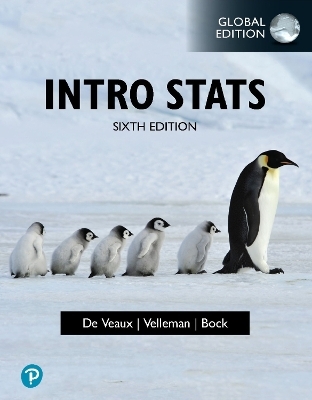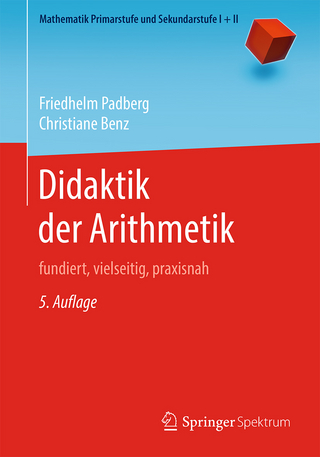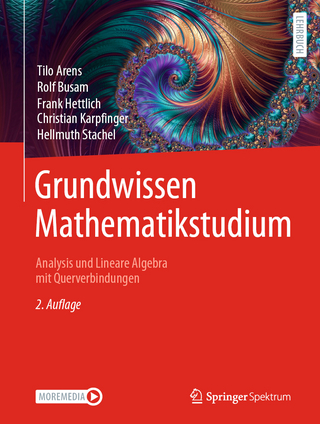
Intro Stats, Global Edition
Pearson Education Limited (Verlag)
978-1-292-47064-1 (ISBN)
Innovative methods, technology, and humor encourage statistical thinking
Intro Stats, 6th Edition by De Veaux/Velleman/Bock uses inventive strategies to help students think critically about data, while maintaining the book's core concepts, coverage, and readability. By using technology and simulations to demonstrate variability at critical points throughout the course, the authors make it easier for instructors to teach and for students to understand more complicated statistical concepts later in the course.
This revision includes several enhancements, enriching material with greater use of the authors' signature tools for teaching about randomness, sampling distribution models, and inference. Current discussions of ethical issues have been added throughout, and each chapter now ends with a student project that can be used for collaborative work.
About our authors Richard D. De Veaux is an internationally known educator and consultant. He has taught at the Wharton School and the Princeton University School of Engineering, where he won a Lifetime Award for Dedication and Excellence in Teaching. He is the C. Carlisle and M. Tippit Professor of Statistics at Williams College, where he has taught since 1994. Dick has won both the Wilcoxon and Shewell awards from the American Society for Quality. He is a fellow of the American Statistical Association (ASA) and an elected member of the International Statistical Institute (ISI). In 2008, he was named Statistician of the Year by the Boston Chapter of the ASA, and was the 2018-2021 Vice-President of the ASA. Dick is also well known in industry, where for more than 30 years he has consulted for such Fortune 500 companies as American Express, Hewlett-Packard, Alcoa, DuPont, Pillsbury, General Electric, and Chemical Bank. Because he consulted with Mickey Hart on his book Planet Drum, he has also sometimes been called the "Official Statistician for the Grateful Dead." His real-world experiences and anecdotes illustrate many of this book's chapters. Dick holds degrees from Princeton University in Civil Engineering (B.S.E.) and Mathematics (A.B.) and from Stanford University in Dance Education (M.A.) and Statistics (Ph.D.), where he studied dance with Inga Weiss and Statistics with Persi Diaconis. His research focuses on the analysis of large data sets and data mining in science and industry. In his spare time, he is an avid cyclist and swimmer. He also is the founder of the "Diminished Faculty," an a cappella Doo-Wop quartet at Williams College, and sings bass in the college concert choir and with the Choeur Vittoria of Paris. Dick is the father of 4 children. Paul F. Velleman has an international reputation for innovative Statistics education. He is the author and designer of the multimedia Statistics program ActivStats, for which he was awarded the EDUCOM Medal for innovative uses of computers in teaching statistics, and the ICTCM Award for Innovation in Using Technology in College Mathematics. He also developed the award-winning statistics program Data Desk, the Internet site Data and Story Library (DASL) which provides data sets for teaching Statistics, and the tools referenced in the text for simulation and bootstrapping. Paul's understanding of using and teaching with technology informs much of this book's approach. Paul taught Statistics at Cornell University, where he was awarded the MacIntyre Award for Exemplary Teaching. He is Emeritus Professor of Statistical Science from Cornell and lives in Maine with his wife, Sue Michlovitz. He holds an A.B. from Dartmouth College in Mathematics and Social Science, and M.S. and Ph.D. degrees in Statistics from Princeton University, where he studied with John Tukey. His research often deals with statistical graphics and data analysis methods. Paul co-authored (with David Hoaglin) ABCs of Exploratory Data Analysis. Paul is a Fellow of the American Statistical Association and of the American Association for the Advancement of Science. Paul is the father of 2 boys. In his spare time he sings with the acapella group VoXX and studies tai chi. David E. Bock taught mathematics at Ithaca High School for 35 years. He has taught Statistics at Ithaca High School, Tompkins-Cortland Community College, Ithaca College, and Cornell University. Dave has won numerous teaching awards, including the MAA's Edyth May Sliffe Award for Distinguished High School Mathematics Teaching (twice), Cornell University's Outstanding Educator Award (3 times), and has been a finalist for New York State Teacher of the Year. Dave holds degrees from the University at Albany in Mathematics (B.A.) and Statistics/Education (M.S.). Dave has been a reader and table leader for the AP Statistics exam and a Statistics consultant to the College Board, leading workshops and institutes for AP Statistics teachers. His understanding of how students learn informs much of this book's approach.
* Indicates optional section
I: EXPLORING AND UNDERSTANDING DATA
Stats Starts Here
1.1 What Is Statistics?
1.2 Data
1.3 Variables
1.4 Models
Displaying and Describing Data
2.1 Summarizing and Displaying a Categorical Variable
2.2 Displaying a Quantitative Variable
2.3 Shape
2.4 Center
2.5 Spread
Relationships Between Categorical Variables: Contingency Tables
3.1 Contingency Tables
3.2 Conditional Distributions
3.3 Displaying Contingency Tables
3.4 Three Categorical Variables
Understanding and Comparing Distributions
4.1 Displays for Comparing Groups
4.2 Outliers
4.3 Re-Expressing Data: A First Look
The Standard Deviation as a Ruler and the Normal Model
5.1 Using the standard deviation to Standardize Values
5.2 Shifting and Scaling
5.3 Normal Models
5.4 Working with Normal Percentiles
5.5 Normal Probability Plots
Review of Part I: Exploring and Understanding Data
II: EXPLORING RELATIONSHIPS BETWEEN VARIABLES
Scatterplots, Association, and Correlation
6.1 Scatterplots
6.2 Correlation
6.3 Warning: Correlation ≠ Causation
6.4 *Straightening Scatterplots
Linear Regression
7.1 Least Squares: The Line of "Best Fit"
7.2 The Linear Model
7.3 Finding the Least Squares Line
7.4 Regression to the Mean
7.5 Examining the Residuals
7.6 R2: The Variation Accounted for by the Model
7.7 Regression Assumptions and Conditions
Regression Wisdom
8.1 Examining Residuals
8.2 Extrapolation: Reaching Beyond the Data
8.3 Outliers, Leverage, and Influence
8.4 Lurking Variables and Causation
8.5 Working with Summary Values
8.6 * Straightening Scatterplots: The Three Goals
8.7 * Finding a Good Re-Expression
Multiple Regression
9.1 What Is Multiple Regression?
9.2 Interpreting Multiple Regression Coefficients
9.3 The Multiple Regression Model: Assumptions and Conditions
9.4 Partial Regression Plots
9.5 * Indicator Variables
Review of Part II: Exploring Relationships Between Variables
III: GATHERING DATA
Sample Surveys
10.1 The Three Big Ideas of Sampling
10.2 Populations and Parameters
10.3 Simple Random Samples
10.4 Other Sampling Designs
10.5 From the Population to the Sample: You Can't Always Get What You Want
10.6 The Valid Survey
10.7 Common Sampling Mistakes, or How to Sample Badly
Experiments and Observational Studies
11.1 Observational Studies
11.2 Randomized, Comparative Experiments
11.3 The Four Principles of Experimental Design
11.4 Control Groups
11.5 Blocking
11.6 Confounding
Review of Part III: Gathering Data
IV: FROM THE DATA AT HAND TO THE WORLD AT LARGE
From Randomness to Probability
12.1 Random Phenomena
12.2 Modeling Probability
12.3 Formal Probability
12.4 Conditional Probability and the General Multiplication Rule
12.5 Independence
12.6 Picturing Probability: Tables, Venn Diagrams, and Trees
12.7 Reversing the Conditioning and Bayes' Rule
Sampling Distributions and Confidence Intervals for Proportions
13.1 The Sampling Distribution for a Proportion
13.2 When Does the Normal Model Work? Assumptions and Conditions
13.3 A Confidence Interval for a Proportion
13.4 Interpreting Confidence Intervals: What Does 95% Confidence Really Mean?
13.5 Margin of Error: Certainty vs. Precision
13.6 * Choosing the Sample Size
Confidence Intervals for Means
14.1 The Central Limit Theorem
14.2 A Confidence interval for the Mean
14.3 Interpreting confidence intervals
14.4 * Picking our Interval Up by our Bootstraps
14.5 Thoughts about Confidence Intervals
Testing Hypotheses
15.1 Hypotheses
15.2 P-values
15.3 The Reasoning of Hypothesis Testing
15.4 A Hypothesis Test for the Mean
15.5 Intervals and Tests
15.6 P-Values and Decisions: What to Tell About a Hypothesis Test
More About Tests and Intervals
16.1 Interpreting P-values
16.2 Alpha Levels and Critical Values
16.3 Practical vs. Statistical Significance
16.4 Errors
Review of Part IV: From the Data at Hand to the World at Large
V: INFERENCE FOR RELATIONSHIPS
Comparing Groups
17.1 A Confidence Interval for the Difference Between Two Proportions
17.2 Assumptions and Conditions for Comparing Proportions
17.3 The Two-Sample z-Test: Testing the Difference Between Proportions
17.4 A Confidence Interval for the Difference Between Two Means
17.5 The Two-Sample t-Test: Testing for the Difference Between Two Means
17.6 * Randomization-Based Tests and Confidence Intervals for Two Means
17.7 * Pooling
17.8 * The Standard Deviation of a Difference
Paired Samples and Blocks
18.1 Paired Data
18.2 The Paired t-Test
18.3 Confidence Intervals for Matched Pairs
18.4 Blocking
Comparing Counts
19.1 Goodness-of-Fit Tests
19.2 Chi-Square Tests of Homogeneity
19.3 Examining the Residuals
19.4 Chi-Square Test of Independence
Inferences for Regression
20.1 The Regression Model
20.2 Assumptions and Conditions
20.3 Regression Inference and Intuition
20.4 The Regression Table
20.5 Multiple Regression Inference
20.6 Confidence and Prediction Intervals
20.7 * Logistic Regression
20.8 * More About Regression
Review of Part V: Inference for Relationships
Parts I–V Cumulative Review Exercises Appendixes:
Answers
Credits
Indexes
Tables and Selected Formulas
| Erscheinungsdatum | 28.09.2024 |
|---|---|
| Verlagsort | Harlow |
| Sprache | englisch |
| Themenwelt | Mathematik / Informatik ► Mathematik |
| ISBN-10 | 1-292-47064-X / 129247064X |
| ISBN-13 | 978-1-292-47064-1 / 9781292470641 |
| Zustand | Neuware |
| Haben Sie eine Frage zum Produkt? |
aus dem Bereich


